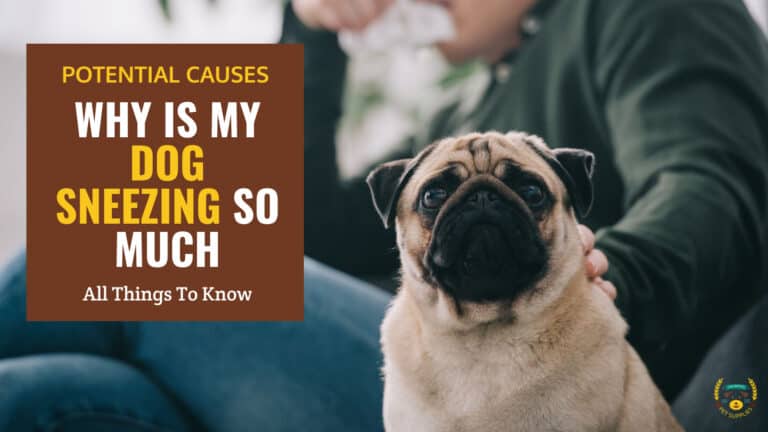How To Stop Your Dog From Biting And Nipping When Excited
Last updated: April 21, 2024

Summary
- Use positive reinforcement like treats and clicker training to encourage good behavior.
- Distract from nipping with chew toys and treats. Give calm timeouts if needed.
- Exercise like walking helps redirect energy. Create a relaxing environment.
- Avoid punishments. Teach gentler play. Seek professional trainer guidance.
- Be confident issuing commands. Monitor progress, adjust techniques as needed.
Dog biting and nipping when excited can be a source of concern for dog owners. It is important to take steps in order to prevent this behavior, both for the safety of others as well as to ensure that the dog remains happy and healthy.
This article will provide an overview of how to stop a dog from biting and nipping when excited. It will discuss techniques such as positive reinforcement, redirecting behaviors, providing adequate exercise, and setting clear boundaries.
With these strategies, it is possible to reduce or even eliminate the unwanted behavior so that everyone involved can enjoy peace and harmony.
- 1) Understanding The Causes Of Biting And Nipping
-
2)
How To Deal With Dog Nipping And Biting?
- 2.1) Offer Positive Reinforcement
- 2.2) Distract With Treats
- 2.3) Give A Timeout
- 2.4) Use A Taste Deterrent
- 2.5) Utilize A Leash For Control
- 2.6) Abstain From Punishment
- 2.7) Exercise Your Dog
- 2.8) Promote Rest And Relaxation & Create a Positive Environment
- 2.9) Practice Simulated Situations
- 2.10) Remain Confident And Assertive
- 2.11) Teach Relaxation Techniques
- 2.12) Refrain From Yelling Or Physical Tactics
- 2.13) Contact A Professional Trainer
- 2.14) Monitor Progress And Adjust Tactics As Needed
-
3)
Frequently Asked Questions
- 3.1) At what Age Should I Start To Train My Dog To Stop Biting And Nipping?
- 3.2) How Do I Know If My Dog Is Biting And Nipping Out Of Fear Or Excitement?
- 3.3) How Much Exercise Does My Dog Need To Stop Biting And Nipping?
- 3.4) Is It Possible To Train An Older Dog To Stop Biting And Nipping?
- 3.5) What Is The Best Way To Ensure That My Dog Does Not Revert To Biting And Nipping Behaviors?
- 4) Conclusion
Understanding The Causes Of Biting And Nipping

Biting and nipping in dogs are often associated with aggressiveness, but this type of behavior can also be caused by a lack of bite inhibition, which is the ability to control the force of their bites when interacting with humans or other animals.
Puppy nipping is common as they explore and learn about their environment through play, which includes using their mouth. While puppy nipping is generally considered more harmless than an adult dog biting, it’s important to stop any kind of biting before it becomes habitual.
Biting can also be your dog's way of seeking attention; you must teach them from an early age that biting results in attention being removed or redirected away from them. They need to sit down and be calm before getting attention.
Another common reason is teething, as puppies between the ages of 3 and 6 months go through a teething phase during which their teeth are growing and developing, causing discomfort in their gums. Chewing on objects or nipping at hands and feet can relieve the discomfort.
Fear or anxiety are common causes, too. Dogs that are anxious or fearful may nip or bite as a way to protect themselves. This behavior can be addressed through behavior modification and training.
Check Also: Best Chew Proof Indestructible Beds for Dogs
Other causes of nipping may also include play and communication, lack of socialization with other dogs and humans, establishing dominance, and less frequently it is a sign of medical problems like dental pain.
It is crucial to pinpoint the exact cause of the behavior before you can do something about it; the solution may be as simple as a visit to the vet or a canine behaviorist.
How To Deal With Dog Nipping And Biting?
There are certain ways you can deal with your dog's disruptive behavior, especially when the biting gets too frequent and excessive. Combining many techniques is usually the way to go.
Let's dive into the most common ways to fix a dog's nipping and biting.
Offer Positive Reinforcement

Positive reinforcement is a technique that involves rewarding desired behaviors with treats or verbal praise, while ignoring undesirable behavior.
Clicker training has been found to be an especially helpful tool for teaching dogs proper socialization skills. The clicker makes a distinct sound that the dog learns to associate with a reward, such as a treat or praise from their owner.
If done properly it can effectively reduce aggressive bites in even the most difficult-to-train animals.
Professional dog trainers can provide guidance on how best to utilize clicker training techniques for the prevention of unwanted behavior such as nipping and biting and establish better communication between the pet and the parent.
Distract With Treats
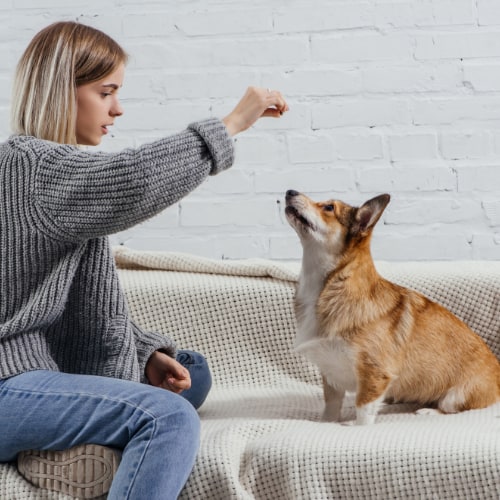
One technique that can be used involves distracting with treats. Treats should be soft, such as kibble or puppy-friendly treats so they do not damage the teeth of your pet.
Start by introducing the treat without any physical contact from you (whenever the pet starts nipping). Allow your pup to take it from your hand or off the ground if needed. Repetition will help create positive associations which in turn reduces aggression-related activities like biting and nipping.
It is important to ensure that rewards are given only after desired behaviors have been achieved rather than prior to them being carried out. This helps teach self-control, develops trust between owner and pet, and eventually decreases unwanted behavior.
Give A Timeout
The use of timeouts involves removing attention from the dog while they are in the middle of an over-excited moment. This will not only teach them to stop their behavior but also show them that there are consequences for it.
When giving your dog a timeout, make sure you get their attention before doing so. If they don't understand why they're being reprimanded, then it's likely that the timeout won't have any meaningful effect.
Additionally, if teeth were involved during the nipping or biting incident, make sure to address this as well. You may choose to give the person who was bitten some sort of reward for enduring the bite without retaliating and teaching your pet appropriate social behaviors at once.
Once these steps have been taken, monitor how long your dog has been in timeout and ensure they stay calm throughout it. Afterward, provide positive reinforcement by offering rewards like treats or extra playtime whenever they respond positively to commands given during moments of excitement.
Use A Taste Deterrent

When puppies are teething, they can be tempted to use their baby teeth on something that feels good - like human skin or clothing. If a puppy bites down too hard during playtime, the taste of an unpleasant substance may deter them from doing it again.
This method works best when used as soon as possible after the incident has occurred. Many substances have been found effective at discouraging puppies from biting humans while they pass through the puppy stage. These include hot sauce, tabasco sauce, apple cider vinegar, and lemon juice diluted with water.
In all instances, it is important not to overuse these ingredients since this could cause further discomfort for your pet. It is also recommended that attention from humans be limited when using this technique so that puppies do not associate negative feelings with people rather than just their behavior.
Utilize A Leash For Control
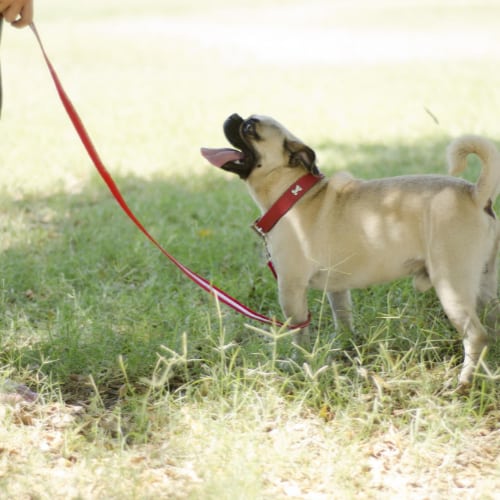
Utilizing a leash with a training collar (If necessary) while walking or exercising with your dog can help you to better control them when they become overexcited. A training plan should be established, and consistent reinforcement of the rules should be practiced in order for it to work properly.
If needed, professional training advice should also be sought from a qualified trainer. This can help ensure that proper techniques are being used and will aid in curbing any unwanted behaviors.
Effective use of a convenient leash and related training methods can improve the overall relationship between pet owner and their four-legged companion.
Check Also: The 10 Best Retractable Dog Leashes - Reviews & Buying Guide
Abstain From Punishment
It is important to abstain from punishing your dog for unwanted behaviors. Teaching alternative behaviors that emphasize gentle behavior can help stop the habit of nipping and biting more effectively.
In order to help teach your pup alternative behaviors, it is essential to understand their instincts as they are natural responses to certain stimuli. Below is a table outlining some common canine instinctual behaviors along with potential alternatives:
| Common Instincts | Alternative Behaviors |
|---|---|
| Chewing | Providing chew toys/treats |
| Barking | Going on walks/providing enough exercise |
| Jumping on people | Sitting politely upon request |
| Nipping/Biting | Providing treats/positive reinforcement |
If you find yourself still having difficulty teaching your pup, then consider seeking professional services through certified trainers who specialize in positive reinforcement-based training.
Exercise Your Dog
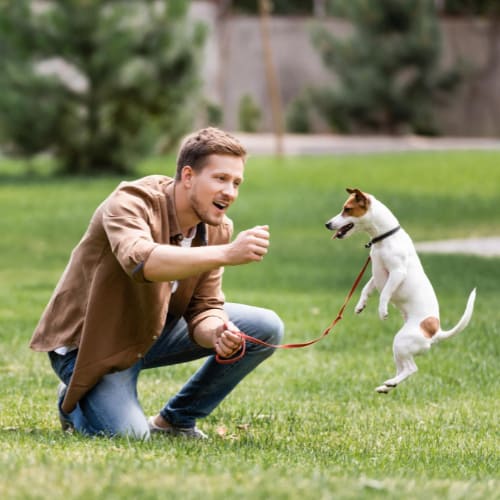
Exercise allows the dog to redirect their energy into physical activities, which can help with calming behaviors. However, it should be done properly and consistently to achieve long-term results.
A common exercise used by many owners is called ‘alpha roll’, which involves gently pushing the dogs onto their side or back until they are compliant and calm. This process teaches the dog that you are the leader of its pack and must be respected accordingly. This technique has recently been considered controversial due to potential negative effects on the mental health of some dogs.
A better alternative is running or walking. Walk with your dog to a park and let it walk and run, preferably with other dogs. While walking is a low-impact exercise that can be tailored to the dog's age, size, and energy level, running is a high-energy exercise that is great for dogs that have a lot of energy to burn, and should be with young puppies or dogs that are prone to joint problems.
Swimming is a great exercise for dogs that love the water. It can be especially beneficial for dogs with joint problems. It's important to supervise dogs when they are swimming and ensure they can safely get in and out of the water.
Fetch is another fun game that can provide great exercise for dogs. It is important to choose a safe location to play, and to avoid using objects that can be easily swallowed or cause injury.
Finally, Agility training is a fun and challenging exercise that can help improve a dog's coordination, strength, and agility. It involves running through an obstacle course that includes jumps, tunnels, and other challenges.
Promote Rest And Relaxation & Create a Positive Environment
Award-winning dog trainer, Ben Randall, recommends promoting rest and relaxation as a way to stop unwanted behaviors such as biting and nipping. He suggests several techniques to achieve this goal:
| Technique | Description | Benefits |
|---|---|---|
| Regular Exercise | Create a calm environment while training by having minimal distractions both inside and outside the home. Also, make sure all family members are aware of how to interact with the pet in an appropriate manner. | Exercise helps reduce anxiety and stress levels which will help prevent excessive energy from manifesting itself into negative behavior. |
| Calm Environment | Create a calm environment while training by having minimal distractions both inside and outside the home. Make sure all family members are aware of how to interact with the pet in an appropriate manner. | Creating a calming environment allows your pup to focus better on commands, lessening their chances of misbehaving due to overstimulation or confusion/frustration. |
| Positive Reinforcement Training | Train using positive reinforcement methods, rewarding desired behaviors instead of punishing undesirable ones. Provide plenty of treats during each session so they can associate good behaviors with rewards quickly and efficiently. | Positive reinforcement provides results quicker than any other method because dogs learn faster when rewarded for wanted actions rather than punished for unwanted ones. |
By following these steps - Ben Randall’s Positive Reinforcement Method (PRM), owners can help create an atmosphere where their pooch feels relaxed and secure; therefore decreasing the likelihood of them exhibiting undesirable behaviors.
Providing ample opportunities for restful sleep also aids in lowering potential stress levels that trigger aggressive reactions.
Practice Simulated Situations
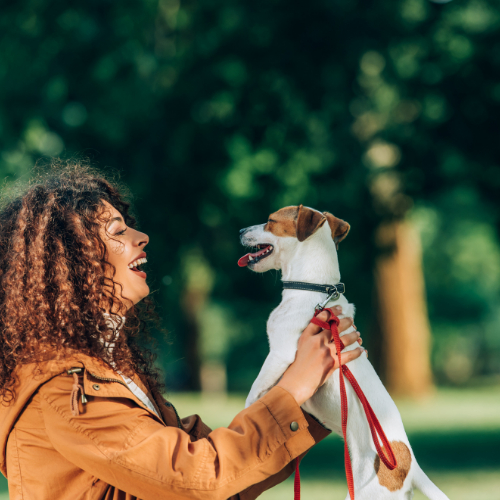
Prevention of animal bites begins by understanding the underlying cause. Resources for animal owners, such as trainers or obedience classes, may provide instructions on how to properly train a dog in order to reduce unwanted behaviors.
Simulated situations should also be practiced in order to better prepare pet owners if they encounter similar circumstances. These simulated scenarios should involve introducing guests into the home or having family members act like strangers who approach the dog on walks.
It is important that all participants remain aware of body language and limit touching until commands are issued from the owner and obeyed by the canine companion.
It takes time and dedication but implementing strategies tailored specifically to each individual pet will result in long-term success.
Check Also: What Do You Do if An Off-Leash Dog Approaches You While You Are Walking a Dog?
Remain Confident And Assertive
Nipping and biting can thus be discouraged by remaining firm yet gentle when disciplining a pup, thereby making sure that all interactions between human and canine are positive ones.
Stay calm and avoid getting angry or nervous during the process, as animals can sense emotions, and getting upset can make the situation worse.
Also, use a firm tone and pay attention to your body language while issuing commands or correcting unwanted behavior. Avoid yelling or shouting at the dog, and Stand up straight, make eye contact, and use hand gestures to signal what you want your dog to do.
Following these steps ensures clear communication and fosters healthy relationships between both parties.
Teach Relaxation Techniques

It is important to learn and teach relaxation techniques that can be used in a variety of situations.
The most common methods for teaching relaxation include those advocated by animal welfare nonprofit organizations and old-school dog trainers alike. These range from positive reinforcement strategies like clicker training, verbal commands, and treats to more traditional physical corrections such as alpha roll (mostly avoided due to potential issues) or leash jerks.
Some part owners even resort to unusual relaxation techniques to help calm their pets; these include massages, aromatherapy (using lavender or camomille scents), music or white noise, and Tellington Touch (TTouch)- circular movements and light pressure on specific points of the body to help the dog relax.
Each technique has its advantages and disadvantages depending on the situation and should be discussed carefully with an experienced trainer before being implemented with a pup.
Refrain From Yelling Or Physical Tactics
According to the ASPCA (The American Society for the Prevention of Cruelty to Animals), a leading animal welfare nonprofit, alpha rolls, widely used by old-school dog trainers in the past, should be avoided as they can lead to fear or aggression in dogs.
Herding the pet around with a stern expression is also not recommended as this will only last for short periods of time before the dog goes back to their original state, potentially escalating bad behaviors even further.
Instead, positive reinforcement such as treats or verbal praise is suggested along with redirecting attention away from situations that could cause excitement and possibly lead to aggressive behaviors.
Contact A Professional Trainer

Trainers are knowledgeable in canine psychology, behavior modification techniques, as well as providing overall guidance for pet owners. It is their expertise that makes them invaluable in addressing behavioral problems.
To understand how a professional trainer helps address this issue, it is important to recognize what causes dogs to bite and nip.
Generally speaking, these behaviors stem from either excitement or anxiety; they may also signal dominance or aggression if left unchecked.
By working together with an expert who has experience dealing with problematic canine behavior, you will take tangible steps toward solving the problem at hand.
Monitor Progress And Adjust Tactics As Needed
Once a professional trainer has been contacted, it is important to monitor the progress of your dog and adjust tactics as needed.
In situations where positive reinforcement and distraction methods do not seem successful, more drastic measures may need to take place such as using leash corrections when appropriate and teaching commands like “sit” or “down' which are useful in redirecting behavior away from nipping.
If necessary, timeouts may also be used as punishment for undesirable behaviors; however, this should only be done after other approaches have failed.
Monitoring and adjusting the strategies adopted will help achieve better and faster results. Regular checkups with trainers during this process will help ensure that you are making progress and allow any adjustments to be made if needed.
Frequently Asked Questions
So far, we explored a multitude of potential causes of dog nipping and biting, as well as strategies you can adopt to remedy the issue. Let's now answer some frequently asked questions related to the topic at hand.
At what Age Should I Start To Train My Dog To Stop Biting And Nipping?
Training a dog to stop biting and nipping should begin as early as possible. Puppies that have not yet developed bad habits are easier to train than older dogs with existing behaviors.
Starting training as early as the age of 15 weeks; however, socializing puppies from an even younger age can help them get used to being around people and other animals in order to reduce excitement-related aggression.
Teaching basic obedience commands such as “sit” or “stay” during this time frame helps reinforce positive behavior and discourage unwanted biting.
How Do I Know If My Dog Is Biting And Nipping Out Of Fear Or Excitement?
When attempting to distinguish between fear or excitement as the cause of a dog's biting and nipping behavior, there are certain cues that can be observed.
Fear-based aggression is often displayed in an animal with its ears back, eyes wide, body low and stiff, hiding behind objects or people, and licking its lips; whereas signs of excitement include barking, jumping up on people, waving the tail, and running around rapidly.
Additionally, if the behavior occurs when visitors come over or when new toys/treats are presented, it may indicate that the dog is displaying excited rather than fearful behaviors.
How Much Exercise Does My Dog Need To Stop Biting And Nipping?
The amount of exercise required can vary depending on the breed, size, age, and health status of the individual dog.
Generally speaking, most dogs need a minimum of 30 minutes of physical activity per day in order to stay healthy and mentally stimulated.
For puppies and high-energy breeds such as retrievers or terriers, it is advisable for them to have at least one hour of vigorous physical exercise daily; this may include running or playing fetch with their owners.
Engaging the pet in activities that require concentration can also help alleviate anxious behavior which could lead to unwanted biting or nipping.
Is It Possible To Train An Older Dog To Stop Biting And Nipping?
Training an older dog to stop biting and nipping is possible, although it may require greater effort than training a puppy.
Depending on the age of the dog, they may have already developed habits that will need to be addressed through additional guidance.
Establishing boundaries early in the process can help with teaching good behavior and discouraging bad behaviors.
What Is The Best Way To Ensure That My Dog Does Not Revert To Biting And Nipping Behaviors?
Training a dog to stop biting and nipping may be particularly challenging for older dogs, as their behaviors are often more deeply ingrained.
The most successful approach is to use positive reinforcement-based methods such as reward-based training or clicker training.
These techniques should be implemented consistently over the course of several weeks in order to ensure that the desired behavior is being reinforced and that any undesirable behaviors, such as biting and nipping, are discouraged.
Conclusion
Nipping and biting dogs can become an annoying habit, and many pet owners face a lot of difficulty in dealing with the issue.
In this article, we provided everything you need to know to reduce or even eradicate dog nipping and biting (and any bad behavior). We went through some root causes of the issue, and the most common and effective strategies to adopt to ensure your pet is well-behaved.
If you still have any questions or comments, please contact us; we will assist you the best (and as soon as) we can!






